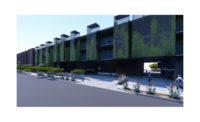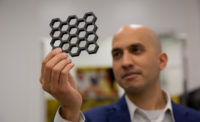The University of Arizona marked the completion of construction and opening of the $85 million Applied Research Building (ARB), a one-of-a-kind advanced research facility that further solidifies and advances the university’s reputation in space research. Located at the southeast corner of Helen Street and the Highland Corridor and delivered utilizing a progressive design-build partnership between integrated design firm SmithGroup and general contractor McCarthy Building Companies, Inc., the 89,000-square-foot ARB is among the first buildings in the country to house all research spaces related to the fabrication and testing of satellites in one integrated facility.
The ARB is the new home of applied physical sciences and engineering, connecting faculty across four colleges and eight departments — college of engineering (aerospace and mechanical, electrical and computer, material science and engineering, and systems and industrial); college of science (astronomy, lunar, and planetary lab); college of optical sciences; and the college of medicine — enabling cutting-edge space science and exploration, advanced manufacturing, and imaging technology research essential to storied missions like the giant magellan telescope and Mars exploration rover.
A Collaborative Center of Space and Atmospheric Research
Partnering with NASA and other federal agencies, the University of Arizona is one of the nation’s top academic institutions for research funding in astronomy and astrophysics, and space science is a key component of the University’s strategic plan to tackle “pressing grand challenges.” The new building offers a range of facilities to enable this advanced research, including one of the largest thermal vacuum chambers of any university in the world, which simulates environmental space conditions to test balloon and satellite performance; high bay payload assembly areas used for constructing high-altitude stratospheric balloons and nanosatellites, also known as “CubeSats;” a non-reflective, echo-free room called an anechoic chamber to test antennae for command, control, and data relay purposes; and a large, dynamic testing lab for testing the performance of a range of objects from airplane wings to sensors.
“With three stories and 89,000 square feet, the Applied Research Building represents an important expansion of our infrastructure for highly specialized applied research in optics, advanced manufacturing, space science and exploration, and more,” said Elizabeth Cantwell, senior vice president for research and innovation, University of Arizona. “These are high-impact fields that not only touch but drive forth several aspects of the Fourth Industrial Revolution. Applied research capabilities and outcomes will be augmented with state-of-the-art equipment and technology and several interdisciplinary university programs working together under one roof.”
ARB Design and Construction Overview
“Befitting the cutting-edge work occurring within, the new ARB is a space-age marvel,” said Mark Kranz, design director, SmithGroup. “Radical in design, the building itself is a highly calibrated machine, uniquely suited to house complex and sensitive research demands with optimal performance in its desert environment.”
“As bold and wondrous as space exploration itself, the ARB serves as a high-tech container for some of the most unique research in the world and builds on SmithGroup’s extensive portfolio of scientific research facilities,” said Stephanie Mitrovic, Phoenix science and technology studio leader, SmithGroup.
A stunning showcase of scientific advancements, the ARB houses an array of rare, space-specific instruments and equipment. The third floor is dedicated to material characterization, imaging, optics, and advanced electronics clean rooms and laboratories, all in support of the research devices and componentry on the floors below. An anechoic chamber on the ground level provides an environment for sound testing of satellite communications, alongside the building’s centerpiece, a two-story, 40-ton thermal vacuum chamber that simulates the environmental conditions found in space. Exaggerated, 40-foot-high bay labs with 30-foot-high doors on the building’s north side are used for constructing high-altitude stratospheric balloons and nanosatellites. As payloads are assembled, they move in a linear workflow south through the building into progressively cleaner space, terminating at the thermal vacuum chamber.
The size of the payloads drove the overall size of the ARB, which creates a striking presence in the engineering precinct at the heart of the Arizona campus. The design capitalizes on its prominent location, adjacent to a primary vehicular route through campus as well as a key pedestrian/bike corridor and tunnel that was reconfigured for safer, better access. The building’s entrance is positioned at this multi-modal hub and new campus portal, where the thermal vacuum chamber is on display like a jewel in the glassy volume of the two-story lobby. Space science influenced the building’s design inside and out and its response to the desert climate. Its crinkled metal skin takes cues from the solar array of the International Space Station with textured vertical fins, breathable rain screen, and integrated frit that mitigate the intensity of the Sonoran sun. All water is recaptured on-site, stored below grade, and filtered through a series of bio-swales and rain gardens. While the ARB’s research requires sophisticated air and exhaust systems for safety, its mechanical systems are designed 30% more efficiently than the ASHRAE baseline for this building type. The design-build project is pursuing LEED Silver certification through the U.S. Green Building Council.
"The University of Arizona has been a leader in design-build and this project is a great example of how the process brings a vision to life and provides the community that it serves a facility that will achieve remarkable things," said Antonya Williams, executive vice president of McCarthy’s education group. “Through its truly collaborative culture, the university's planning design and construction group provided a foundation for the project team to innovate and find solutions to every challenge, particularly those that are uncommon due to the nature of the research being conducted, so the goals were achieved successfully. We are grateful to have helped deliver this world-class project for the university and are thrilled that it will function to continue fostering a culture of collaboration for the campus and its researchers.”
The university has used the design-build delivery method for the past 30 years to create collaborative project teams and establish a platform for innovation on projects. The ARB project team developed solutions to overcome challenges related to supply chain constraints and find solutions for the installation of highly specialized equipment, including the thermal vacuum chamber. Additionally, the team employed modeling of custom workspaces, which was particularly effective for allowing end users to experience their space and inform the decision-making process. Collaboration was also critical in minimizing campus impact and ensuring the safety of students, faculty, staff, and the general public during construction due to the building’s central location on campus.
The ARB’s team began the progressive design-build process in Fall of 2019 and the project groundbreaking occurred in June 2021. SmithGroup and McCarthy Building Companies served as progressive design-build partners on the ARB. SmithGroup provided integrated design services, including architecture, fire protection and life safety engineering, interiors, lab planning, landscape architecture, lighting design, MEP engineering, and programming. McCarthy self-performed various aspects of the project, which helped to maintain the schedule, particularly since much of the work on the project occurred during the COVID-19 pandemic. Other project trade partners include Sturgeon Electric, Comfort Systems, Dibble Corporation, Magnum Paving, Martin, White & Griffis Structural Engineers, Sextant, Colin Gordon, and Speedy and Associates.




